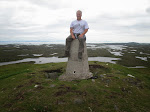White-crowned Sparrow – Cley-next-the-Sea, Norfolk, 10th January 2008
Although it had apparently been around since the 3rd January 2008, the rather incredible news of a White-crowned Sparrow in Cley-next-the-Sea first emerged at midday on Sunday the 6th January 2008. Later that week I was with the erstwhile love of my life in Ryton-on-Dunsmore for my ‘regular’ six days or so with her until her children returned home on the following Sunday evening.
Obviously, on the basis of the mantra ‘go as soon as possible’ I was very keen to see the bird as soon as possible.
However, as the bird was in Cley-next-the-Sea in North Norfolk there was a counter argument to wait until Elizabeth was able to come with me. Just when this would be wasn’t necessarily clear, so in the end, under the pressure of dipping, I cracked and twitched from on my own on Thursday the 10th January.
North Norfolk from Warwickshire was an interesting drive. But, whatever, I successfully arrived in Cley in a timely manner and managed to park up. As it was both mid-week, but a few days after the news was released, the crowds present weren’t too large. I joined the crowd assembled alongside the Cley-Holt road opposite the house of the original ‘finders’, the Bendings, from where the bird could be seen when it came out to feed on the seed that had been scattered on the drive to facilitate the management of the twitch.
As a result of the management of the twitch and the timing of my visit I quickly and easily enjoyed excellent views of an adult White-crowned Sparrow in Cley, in January!!!! Not a bird I had particularly envisaged catching up with anywhere, let alone in these circumstances.
Having visited Texas on a birding trip in April 1992, and honeymooned and birded and worked and birded in California in 1997 and 2000 respectively, I was already familiar with Zonotrichia sparrows, but needless to say, this particular one got a good coat of looking at.
The under-parts were a pale slate grey merging into a more olive on the rear flanks. The face, neck, collar and upper back were also pale slate grey. The rest of the upper-parts were a complex mix. The mantle and the scapulars were same grey with russet brown streaking and the remiges and the coverts were similar but had black centres and white fringes or tips, which created two distinct wing-bars.



No comments:
Post a Comment